
Oldsmobile was a brand of American automobiles, produced for most of its existence by General Motors. Originally established as "Olds Motor Vehicle Company" by Ransom E. Olds in 1897, it produced over 35 million vehicles, including at least 14 million built at its Lansing, Michigan factory alone. During its time as a division of General Motors, Oldsmobile slotted into the middle of GM's five divisions, and was noted for several groundbreaking technologies and designs.
Robert Carl Stempel was a Chairman and CEO of General Motors (GM) from August 1990 to November 1992. He joined GM in 1958 as a design engineer at Oldsmobile and was key in the development of the front-wheel drive Toronado. He was also involved with the team that created the first catalytic converter.
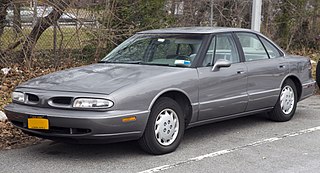
The Oldsmobile 88 is a full-size car that was sold and produced by Oldsmobile from 1949 until 1999. From 1950 until 1974, the 88 was the division's most profitable line, particularly the entry level models such as the 88 and Dynamic 88. The 88 series was also an image leader for Oldsmobile, particularly in the early years (1949–51), when it was one of the best performing automobiles, thanks to its relatively small size, light weight, and advanced overhead-valve high-compression V8 engine. This engine, originally designed for the larger C-bodied and more luxurious 98 series, also replaced the straight-8 on the smaller B-bodied 78. With the large, high performance V8, the Oldsmobile 88 is considered by some to be the first muscle car, although this title is disputed.

The Oldsmobile Toronado is a personal luxury car manufactured and marketed by the Oldsmobile division of General Motors from 1966 to 1992 over four generations. The Toronado was noted for its transaxle version of GM's Turbo-Hydramatic transmission, making it the first U.S.-produced front-wheel drive automobile since the demise of the Cord in 1937.
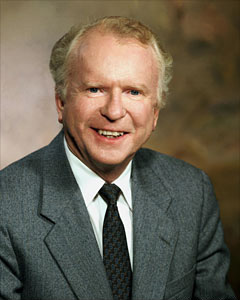
Roger Bonham Smith was the chairman and CEO of General Motors Corporation from 1981 to 1990, and is widely known as the main subject of Michael Moore's 1989 documentary film Roger & Me.

The Oldsmobile Starfire is an automobile nameplate used by Oldsmobile, produced in three non-contiguous generations beginning in 1954. The Starfire nameplate made its debut as a stylish convertible concept car in 1953 followed with the 1954–1956 Ninety-Eight series convertibles that shared a "halo status" with the Buick Skylark and Cadillac Eldorado. For 1957 only, all Ninety-Eight series models were named "Starfire 98".

The Buick V6, popularly referred to as the 3800 in its later incarnations, originally 198 cu in (3.2 L) and initially marketed as Fireball at its introduction in 1962, was a large V6 engine used by General Motors. The block is made of cast iron and all use two-valve-per-cylinder iron heads, actuated by pushrods. The engine, originally designed and manufactured in the United States, was also produced in later versions in Australia. It was the first six-cylinder engine designed exclusively for Buick products since the Buick straight-six was discontinued in 1930.
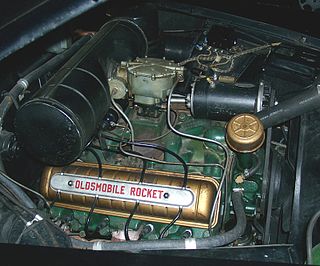
The Oldsmobile V8, also referred to as the Rocket, is series of engines that was produced by Oldsmobile from 1949 to 1990. The Rocket, along with the 1949 Cadillac V8, were the first post-war OHV crossflow cylinder head V8 engines produced by General Motors. Like all other GM divisions, Olds continued building its own V8 engine family for decades, adopting the corporate Chevrolet 350 small-block and Cadillac Northstar engine only in the 1990s. All Oldsmobile V8s were manufactured at plants in Lansing, Michigan while the engine block and cylinder heads were cast at Saginaw Metal Casting Operations.
Semon Emil "Bunkie" Knudsen was an American automobile executive.
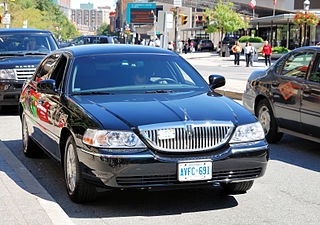
An old man's car is stereotype of a car that appeals to older buyers rather than to younger ones. It is widely held in the United States automobile industry that such cars are difficult to sell. Several automobile manufacturers have taken steps to shake the perception that their cars are intended for an older generation because it tarnishes the brand's image in the eyes of younger buyers.

Noah Bennet, also known as the man in horn-rimmed glasses or simply Mr. Bennet, is a character from the NBC superhero drama Heroes played by Jack Coleman. The role was initially recurring, but became regular as of the 11th episode. His first name was not revealed until "How to Stop an Exploding Man", the first-season finale. Along with his adoptive daughter Claire, Noah is the most frequently seen character in the series, and returned for the 2015-16 miniseries Heroes Reborn.

The Mysterious Rhinestone Cowboy is the third album of American singer David Allan Coe, and his first on Columbia Records. Released in 1974, it is his first release in the country music genre.
Joseph Paruta, also known as "Old Man", was a respected soldier in the Gambino crime family and considered a "key member" of Sammy Gravano's Bensonhurst, Brooklyn crew. He is the only known mobster who asked for a mercy killing after becoming terminally ill with lung cancer. The proposition was not agreed upon by John Gotti but Paruta died before the mercy killing was performed.

Evel Knievel is a 1971 American biographical film starring George Hamilton as motorcycle daredevil Evel Knievel.

Bill Pearce was an American singer, solo trombonist, nationally syndicated broadcaster and inductee into the National Religious Broadcasters Hall of Fame. He died at age 83 on February 23, 2010, from complications of Parkinson's disease.
Hurst Hairy Olds is the name given to a pair of exhibition funny cars campaigned by Hurst Performance in 1966 and 1967.

The Oldsmobile Touring Sedan is a full-size car that was produced by Oldsmobile. Marketed from 1987 to 1993, two generations of the Touring Sedan were produced. Introduced to commemorate the 90th anniversary of Oldsmobile, the model also was an attempt by General Motors to further differentiate Oldsmobile from Buick by marketing it to younger, upscale buyers, and to better compete with European import offerings.
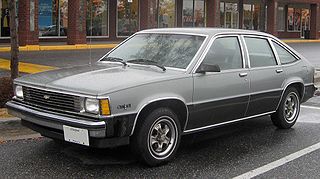
The General Motors second generation, front-wheel drive X-platform was used for compact cars from 1979 to 1985. After front-wheel drive cars had become somewhat mainstream in the North American market, first through foreign imports, and then by American badged but wholly or partially foreign developed cars – for instance the Ford Fiesta and Dodge Omni – GM's 2nd gen X-bodies were the first all-American developed front-wheel drive cars introduced for high-volume, mainstream sales, and initially saw great sales success. They posed an alternative to imported front-wheel drive compacts.
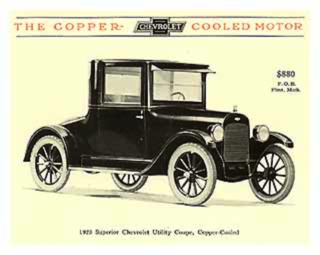
The 1923 Chevrolet Series M Copper-Cooled was an automobile made to be completely air-cooled by Chevrolet in 1923. It was designed by Charles F. Kettering, head engineer of Delco, the General Motors research division wing in Dayton, Ohio. The automobile used a body style from its predecessor, but incorporated an air-cooled engine. Air cooling, as opposed to water-based cooling, was much more practical in a sense because it did not require a radiator, nor the piping that came with it. Although air cooling was not new to the time period, it was new to engines of that scale. The Copper-Cooled Chevrolet was in fact a feasible project; however, the final product did not live up to the standards that Kettering had imagined. The car dangerously overheated in hot weather, and posed a safety hazard to the drivers. Only a few made it to the sales floor, only to be recalled and destroyed by Chevrolet. The 1923 Chevrolet Series M Copper-Cooled consumed extensive amounts of resources to develop and was a failure in the end. The engine was manufactured as an alternative to the Franklin which also used an in-line air-cooled engine.














